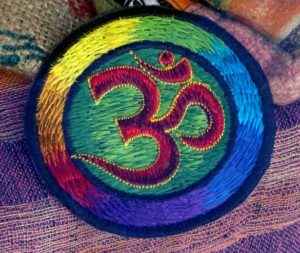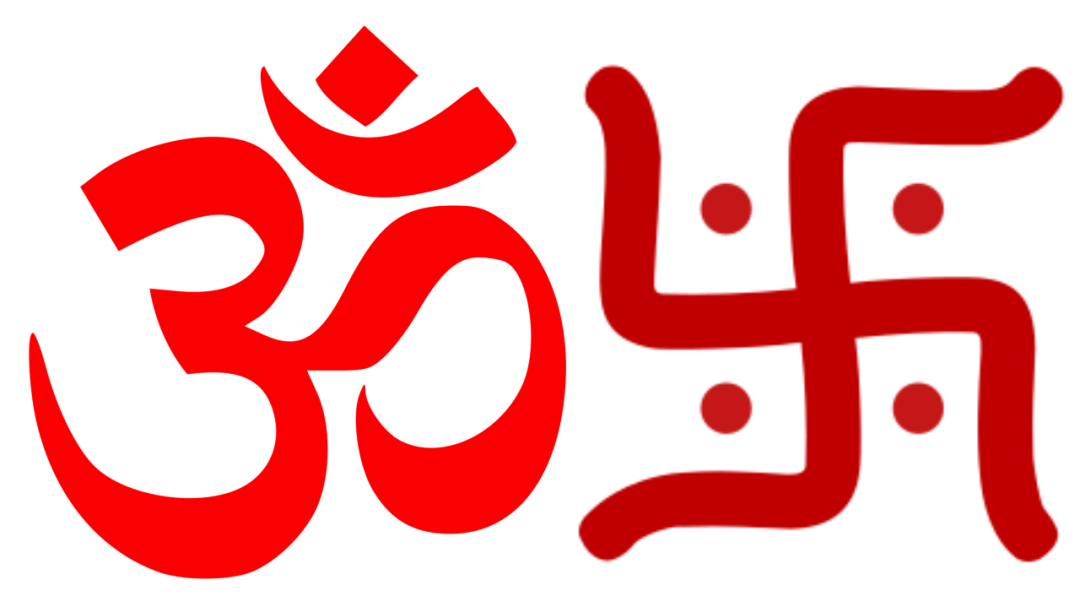Om
Om is the most important religious symbol for Hindus. It is composed of three sounds a-u-m and this threefold nature is central to its significance. It represents the three worlds – earth, air and heaven; the trinity of Hindu Gods – Siva, Vishnu and Brahma and the three Vedic scriptures of Hindus – Rigveda, Yajurveda and Samaveda.
 Hindus believe that Om is the most sacred sound and that the whole universe and everything in the universe exists because of it. Om is used at the start and end of all Hindu prayers, in meditation and in various yoga postures.
Hindus believe that Om is the most sacred sound and that the whole universe and everything in the universe exists because of it. Om is used at the start and end of all Hindu prayers, in meditation and in various yoga postures.
According to the Mandukya Upanishad “Om is the one eternal syllable of which all that exists is but the development. The past, the present, and the future are all included in this one sound, and all that exists beyond the three forms of time is also implied in it.
“There is harmony, peace, and bliss in this simple but deeply philosophical sound. By vibrating the sacred syllable Om, the supreme combination of letters, if one thinks of the Ultimate Personality of Godhead and quits his body, he will certainly reach the highest state of stateless eternity,” states the Bhagvad Gita.
Swastika
Swastika is the second most important religious symbol for Hindus. Its name comes from two Sanskrit words: sv which means well and asti which means is. Hence Swastika meaning all is well and symbolizing good fortune and well-being. The swastika can be seen everywhere in India-temples, paintings, decorations for weddings, on clothes, etc.
Trishul
Trishul is another important Hindu symbol. It is a trident spear symbolizing Hindu God Shiva, with the three prongs representing Shiva as the Creator, Preserver, and Destroyer.
Linga
Linga is the form in which Shiva is most worshipped. The linga is basically a stylized phallus that most often rests on a pedestal of a stylized yoni or female sex organ. Together they represent fertility and creative energy.
Saffron Color
Saffron Color is the color most associated with Hinduism. It is the color of fire and symbolized the Supreme God. The color is also associated with three other religions which originated in India-Sikhism, Jainism, and Buddhism. The color is part of the Indian Flag and represents sacrifice and renunciation on the path to salvation.
Lotus
Lotus symbolizes purity in mind, thought and action. In spite of growing in the mud, lotus retains its purity and beauty and indicates how humans should lead their lives and not let their environment prevent them from working towards their ultimate goal- renunciation of all attachments and freedom from the cycle of birth and death.
Bindi
Bindi is traditionally worn by the married women on their foreheads. It symbolizes female energy and is believed to protect women and their husbands.
Purnakumbha
Purnakumbha is an earthen pot filled with water and with fresh mango leaves and a coconut atop it. It is used during most religious ceremonies and represents Goddess Lakshmi. The pot stands for Mother Earth ( source of all life), water represents life-giving force and the leaves and the coconut represent divine consciousness.
Prasad
Prasad symbolically represents our ignorance which we present to God who then blesses it and transforms it into spiritual knowledge and reinvigorates our bodies. Prasad is shared with others to represent the spreading of this knowledge.
Yajnopavita
Yajnopavita is the sacred thread worn by Brahmins as part of a very sacred ceremony on a very auspicious day. A Brahmin becomes a true Brahmin only after this ceremony. The thread consists of three threads representing the three Gods- Brahma, Vishnu, and Shiva. The knot in the middle represents the Supreme Principle.






